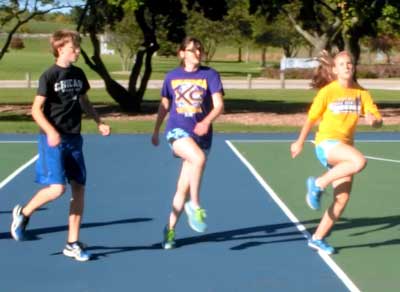
By Ken Jakalski
Over the past twenty years, almost every coach has revised his or her approach relative to the activities runners do prior to racing or training.
Though this preparatory phase is referred to as a warm-up, that concept continues to be discussed and debated. Many believe that athletes who do not warm up leave their athletic potential untapped. As Sue Falsone notes, without a proper warmup, “muscle balances aren’t corrected, range of motion fails to improve, and movement mechanics is limited.”

Many also believe that, though failure to warm up may not directly correlate with short-term injury risk, not warming up can indeed increase the risk of injury or lead to performance decrements.
The key question is whether or not increasing flexibility—often the goal of any warm-up activity—enhances performance. According to Falsone, the research says no, and in fact suggests that too much flexibility may limit performance and increase the risk of injury.
The static component of the conventional warm-up has been a point of controversy going back several years. Coaches have long believed that stretching as part of a warm-up before any high-speed athletic activity makes sense in terms of preparing the body for the demands of these activities while helping to reduce the possibility of injury. However, research does not make a good case for using things like conventional static stretching to enhance athletic performance.
So what is the coach to do?
The process has more coaches doing what Loren Seagrave used to refer to as the “Big” warm-up, a concept that has evolved into what is now referred to as simply the “Dynamic Warm-up.” Dynamic warm-up is a series of movements designed to increase body temperature, activate the nervous system and increase range of motion. D.J. McMillian believes that this dynamic form has a “clear advantage over static stretching when looking at performance tests of power and agility.” These dynamic warm-ups consist of integrated movements that can improve muscular strength, mobility, stability, balance, coordination, and power. I describe what our athletes do as a workout in itself and not just a precursor to some specific workout.
What sets our version of the Dynamic Warm-up apart from others is the following:
- Just about every sequence we do forward we also do backward as well as laterally,
- The movements involve complex forms of skipping, hopping, and galloping that are not easily mastered, and
- A group leader determines the speed, amplitude, and direction of each activity, and every athlete must mimic what the leader is doing.
I’d like to believe this was a completely original concept, but Vern Gambetta coined the term “Speed in Cooperation” over twelve years ago, and our concept is similar. For example, here is Vern’s description of his two player serpentine, one of the many creative drills he has developed for straight ahead speed as well as lateral speed and agility.
“Player A and B start out running parallel to each other with about five yards spacing. Player A will run in a serpentine fashion while player B follows player A’s lead, maintaining a constant spacing between them.”
I refer to what we do as what NASCAR driver Darrell Waltrip calls co-opetition—working together for mutual benefit.
We have fourteen different activities during our opening arm series, with arms in different positions and swinging in unusual ways during each activity.
Reverse Arm Swing
Oca Kerri
Following the arm series, athletes begin our hip series, which involves four different types of what most coaches know as the conventional carioca. Our pattern involves the carioca done backward and with a double bounce before executing the crossover. We also add a rotational activity known as touch-n-spin.
Touch N Spin
The third series is called Impact Abduction/Adduction. In this series, athletes do a forward and lateral jumping jack, but ours is different because the hands and feet come together at the same time. As a result, we refer to that as a “Flapjack.”
Flapjacks
We also do a galloping movement, which looks similar to the Monty Python knights riding without horses, as well as straight leg cross-over swing we call a Slalom Bounce.
The next series involves conventional skips but with an emphasis on the landing foot hitting the ground next to the take-off foot. The second set of our Leg Spring Series involves what we call Skip-Run-1-2-3. Athletes skip once, then take three quick steps before executing the next skip off their other foot. The skip series is further challenging because the routines are also done backward as well as laterally.
Lateral Skips
The complete series ends with our most demanding sequence, quick bounces punctuated by an equally fast tap and recover of the opposite foot. We call this drill the Snap-n-Tap, and it can be further complexed by having athletes clap their hands under their drive leg, or pass an object like a ball or disk from one hand to the other.
Snap N Tap
The complete six-part series can be done with each activity ranging from 50 to 100 meters. Our cross country runners take about seventeen minutes to complete the entire workout, and they average about 1.6 miles worth of activity before they begin their training for the day. The length of each activity gets shorter as the season progresses. At a certain point, we switch from what we call Gravity Constant to Gravity Constant Complexed, which involves a much shorter period of activity, but with various activities combined, like executing a Skip-Run-1-2-3 while doing reverse arm swings. This reduces the total warm-up time but makes the sequences even more challenging.
What is the value in doing these activities in this manner? Part of this is related to the synchronization theory. As Dr. Robert Burton said about altered states through groupthink,
Synchronization is an example of how a behavior as elementary as group clapping can transform one’s personal sense of control. It is hard not to speculate on how ubiquitous this phenomenon is, and how easily it can be used for crowd manipulation. Watch a cheerleader warming up a cheering section, a Marine drill sergeant shouting marching orders, or a great orator, and you get a sense of how easy it is to be swept up into the mesmerizing rhythm and cadence of someone with an agenda.
Running is Neural
This phenomenon is all the more important because, as Dr. Owen Anderson said many years ago, running is a “neural thing.”
According to Jay Dicharry, the neural aspect of running should not be overlooked. “Initial improvements in the ability to generate force,” he notes, “are the result of improvements in neural control. Since the stance phase of running is quite sort, rapid feedback from the nervous system to control joint stability and transfer for is paramount in running. Unfortunately, this is often one of the most overlooked aspects of athletic skill in running.”
The concept of co-opetition relative to our version of the Dynamic Warm-Up does address this neural aspect of running. Athletes are compelled to focus on the movements while concentrating on how the group leader chooses to execute them. They must be prepared to change speeds and direction based what the leader chooses to do. We have found that this focus on mirroring the movements and mechanics of the lead runner—or the runner right in front of them—is a better way for athletes to learn the more difficult activities in the series while achieving the much needed competitive arousal prior to a race and workout.
Please share this article so others may benefit.
[mashshare]References
Burton, Robert A. A Skeptic’s Guide to the Mind: What Neuroscience Can and Cannot Tell Us About Ourselves. , 2013. Print.
Dicharry, Jay. Anatomy for Runners. New York: Skyhorse, 2012. Print.
Falsone, Sue. “Optimising Flexibility.” High Performance Training for Sports. Ed. David Joyce and Daniel Lewindon. Champaign: Human Kinestics, 2014. Print
Gambetta, Vern, and Winckler, Gary. Sport Specific Speed: The 3S System Gambetta Sports Training Systems, Sarasota, 2001. Print.
McMillian, D.J., J.H. Moore, B.S. Hatler, and C.Taylor. “Dynamic vs. static stretching warmup; The effect on power and agility performance.” Journal of Strength and Conditioning Research, 20 (03): (2006): 492-499. Print



Warm up before a workout is very essential because without warming up muscles are not prepared for firing in a maximum throughput and will also lead to injury. Thanks for sharing this information on warmup movements.